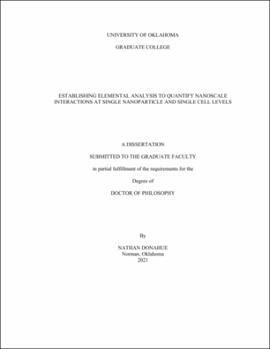| dc.description.abstract | For over two decades, nanoscale materials have been utilized as diagnostics and therapeutics. The successful clinical implementation of these platforms depends on well-defined physicochemical properties. However, such nanoparticle characteristics diverge at the single particle level and fluctuate within biological systems. Moreover, single cell diversity often leads to unpredictable and heterogenous biological outcomes upon nanoparticle exposure. Together, these factors complicate and hinder widespread clinical application of nanomaterials. To that end, there exists a need to quantify both the dynamics of individual nanoparticle physicochemical properties and single cell interactions with nanoparticles. Insights from such fundamental studies could guide the design of novel nanomaterials with better controlled physicochemical properties potentially leading to improved clinical performance. To achieve this goal, quantitative analytical methods that capture both dynamic single nanoparticle transformations and single cell heterogeneity are required. Mass spectrometry based on elemental analysis can be applied to investigate such phenomenon. In the current dissertation, single particle inductively coupled plasma mass spectrometry (SP-ICP-MS) was utilized to quantify the mass, colloidal stability, and chemical composition of model nanoparticles in situ with high throughput. SP-ICP-MS was further applied to quantify the heterogeneous changes of individual nanoparticle physicochemical properties. With established elemental analysis techniques to track the evolution of single nanoparticle physicochemical properties, the cellular uptake of model nanoparticles was then quantified at the single cell level using human B cells. This elemental analysis approach represents a feasible method for measuring the single cell variety of nanoparticle cellular uptake. Collectively, these results represent a new readily accessible tool for the nanomedicine community that is capable of efficiently quantifying nanoparticle mass, colloidal stability, chemical composition, and nanoparticle cellular uptake all on the same mass spectrometer. With this elemental analysis approach, future studies can develop strategies to modulate individual nanoparticle physicochemical properties within physiological settings to better control nanoparticle-cell interactions for improved clinical translation. | en_US |
